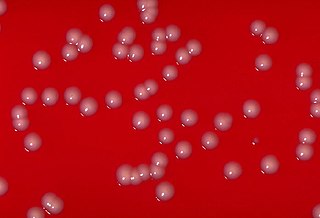The halophiles, named after the Greek word for "salt-loving", are extremophiles that thrive in high salt concentrations. While most halophiles are classified into the domain Archaea, there are also bacterial halophiles and some eukaryotic species, such as the alga Dunaliella salina and fungus Wallemia ichthyophaga. Some well-known species give off a red color from carotenoid compounds, notably bacteriorhodopsin. Halophiles can be found in water bodies with salt concentration more than five times greater than that of the ocean, such as the Great Salt Lake in Utah, Owens Lake in California, the Urmia Lake in Iran, the Dead Sea, and in evaporation ponds. They are theorized to be a possible candidate for extremophiles living in the salty subsurface water ocean of Jupiter's Europa and other similar moons.

Streptomyces is the largest genus of Actinobacteria and the type genus of the family Streptomycetaceae. Over 500 species of Streptomyces bacteria have been described. As with the other Actinobacteria, streptomycetes are gram-positive, and have genomes with high GC content. Found predominantly in soil and decaying vegetation, most streptomycetes produce spores, and are noted for their distinct "earthy" odor that results from production of a volatile metabolite, geosmin.

Burkholderia is a genus of Proteobacteria whose pathogenic members include the Burkholderia cepacia complex, which attacks humans and Burkholderia mallei, responsible for glanders, a disease that occurs mostly in horses and related animals; Burkholderia pseudomallei, causative agent of melioidosis; and Burkholderia cepacia, an important pathogen of pulmonary infections in people with cystic fibrosis (CF). Burkholderia species is also found marine environment. S.I. Paul et al. (2021) isolated and characterized Burkholderia cepacia from marine sponges of the Saint Martin's Island of the Bay of Bengal, Bangladesh.

Corynebacterium is a genus of bacteria that are Gram-positive and most are aerobic. They are bacilli (rod-shaped), and in some phases of life they are, more specifically, club-shaped, which inspired the genus name.

Cyanophycin, also known as CGP or multi-L-arginyl-poly, is a non-protein, non-ribosomally produced amino acid polymer composed of an aspartic acid backbone and arginine side groups.

Polylysine refers to several types of lysine homopolymers, which may differ from each other in terms of stereochemistry and link position.
Streptomyces scabies or Streptomyces scabiei is a streptomycete bacterium species found in soils around the world. Unlike most of the 500 or so Streptomyces species it is a plant pathogen causing corky lesions to form on tuber and root crops as well as decreasing the growth of seedlings. Along with other closely related species it causes the potato disease common scab, which is an economically important disease in many potato growing areas. It was first described in 1892, being classified as a fungus, before being renamed in 1914 and again in 1948. Several other species of Streptomyces cause similar diseases to S. scabies but other, more closely related species, do not.
Streptomyces avermitilis is a species of bacteria in the genus Streptomyces. This bacterium was discovered by Satoshi Ōmura in Shizuoka Prefecture, Japan.
Polyvinyl alcohol dehydrogenase (cytochrome) (EC 1.1.2.6, PVA dehydrogenase, PVADH) is an enzyme with systematic name polyvinyl alcohol:ferricytochrome-c oxidoreductase. This enzyme catalyses the following chemical reaction
Shewanella decolorationis is a gram-negative, dye-decolorizing bacterium first isolated from activated sludge of a waste-water treatment plant. It is motile by means of a single polar flagellum. The type strain is S12T. Its genome has been sequenced.
Methanocella paludicola is a methane-producing archaeon, the type species of its genus. It was first isolated from rice paddy soil, and is mesophilic and hydrogenotrophic, with type strain SANAET.
Streptomyces albofaciens is a bacterium species from the genus of Streptomyces which produces oxytetracycline, spiramycin, albopeptin A, albopeptin B and alpomycin.
Streptomyces celluloflavus is a bacterium species from the genus of Streptomyces which has been isolated from soil in Japan. Streptomyces celluloflavus produces aureothricin and has the ability to degrade cellulose.
Streptomyces exfoliatus is a bacterium species from the genus of Streptomyces which has been isolated from soil. Streptomyces exfoliatus has the ability to degrade poly(3-hydroxyalkanoate). this species produces exfoliatin and exfoliamycin.
Streptomyces graminearus is a bacterium species from the genus of Streptomyces. Streptomyces graminearus produces the antibiotic gougerotin.
Streptomyces griseofuscus is a bacterium species from the genus of Streptomyces which has been isolated from soil in Japan. Streptomyces griseofuscus produces azinomycin A, azinomycin B, bundlin A, bundlin B, moldicidin A, physostigmine, fungichromin and pentamycin.
Streptomyces mobaraensis is a spore forming bacterium species from the genus of Streptomyces. Streptomyces mobaraensis produces bleomycin, detoxin, piericidin A, piericidin B, reticulol and transglutaminase. Streptomyces mobaraensis is used in the food industry to produce transglutaminase to texture meat and fish products.
Streptomyces thermoviolaceus is a thermophilic bacterium species from the genus of Streptomyces which has been isolated from composts. Streptomyces thermoviolaceus produces chitinase and peroxidase.
Streptomyces viridosporus is a bacterium species from the genus of Streptomyces. Streptomyces viridosporus produces sistomycine and lignin peroxidase. Streptomyces viridosporus can degrade lignin and humic acids. Streptomyces viridosporus also produces moenomycin A, a component of bambermycin.
Streptomyces zinciresistens is a filamentous bacterium species from the genus of Streptomyces which has been isolated from a copper and zinc mine in the Shaanxi province in China. Streptomyces zinciresistens is resistant against zinc.




